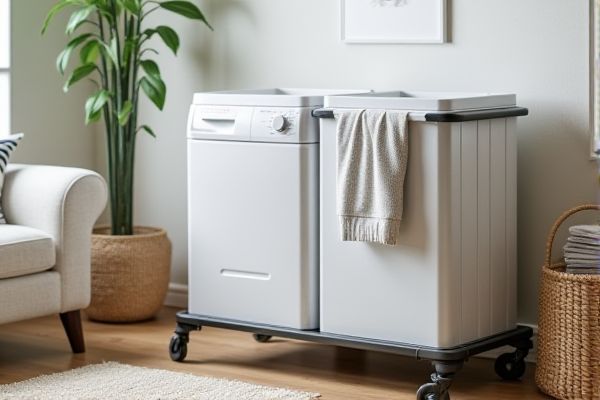
A rolling laundry cart offers mobility and convenience, allowing you to easily transport clothes between rooms, while a stationary laundry sorter provides a fixed location for organizing garments by type or color. Discover which option best suits Your laundry routine by reading the rest of the article.
Table of Comparison
| Feature | Rolling Laundry Cart | Stationary Laundry Sorter |
|---|---|---|
| Mobility | High - Equipped with wheels for easy movement | Low - Fixed position, no wheels |
| Space Efficiency | Compact and flexible for varied spaces | Bulkier, requires dedicated space |
| Sorting Capacity | Usually 2-3 compartments | Typically 3 or more compartments for precise sorting |
| Material | Metal/Wood frame with fabric bags | Wood, plastic, or metal bins |
| Usage | Ideal for transport from laundry room to dryer | Best for organized pre-sorting in laundry area |
| Durability | Moderate, depends on frame and wheels quality | High, sturdy and designed for stationary use |
| Price Range | $30 - $80 | $50 - $150 |
Overview: Rolling Laundry Cart vs Stationary Laundry Sorter
A rolling laundry cart offers mobility and convenience, featuring wheels that allow easy transport of laundry from room to room, making it ideal for multitasking households. In contrast, a stationary laundry sorter provides a structured, fixed solution with multiple compartments for separating clothes by color or fabric type, ensuring organized and efficient sorting. Choosing between the two depends on space availability, frequency of laundry tasks, and the need for portability versus fixed organization.
Key Features Comparison
A rolling laundry cart offers portability with swivel wheels for easy movement between rooms, while a stationary laundry sorter provides a stable, fixed structure often with multiple compartments for sorting clothes by color or fabric type. Rolling carts typically feature a lightweight frame and collapsible design for space-saving, whereas stationary sorters emphasize durability and higher capacity for larger laundry loads. Both types enhance laundry organization but differ in mobility and storage efficiency, catering to varying household needs.
Mobility and Maneuverability
A rolling laundry cart offers superior mobility and maneuverability, allowing you to easily transport clothes between rooms or floors without heavy lifting. Its swivel wheels and lightweight frame enable smooth navigation around tight corners and furniture, reducing strain during laundry tasks. In contrast, a stationary laundry sorter remains fixed in one location, limiting your ability to move laundry loads quickly and efficiently.
Space and Storage Considerations
Rolling laundry carts offer flexible space utilization by easily moving between rooms or storage areas, making them ideal for small or multi-use spaces. Stationary laundry sorters require a designated spot and tend to provide more organized compartments for sorting clothes without frequent rearrangement. Choosing between the two depends on available floor space and the need for mobility versus permanent organization.
Durability and Build Quality
Rolling laundry carts often feature reinforced steel frames and heavy-duty casters designed to endure frequent movement without compromising stability, making them ideal for dynamic laundry spaces. Stationary laundry sorters emphasize robust construction with high-grade materials like hardwood or thick plastic bins, ensuring long-lasting durability and resistance to wear in fixed locations. Both options prioritize strong build quality, but rolling carts must balance sturdiness with mobility, while stationary sorters focus solely on strength and capacity.
Capacity and Organization
Rolling laundry carts typically offer flexible capacity with multiple compartments that allow sorting by color, fabric, or wash type, enhancing organization and mobility. Stationary laundry sorters often provide larger, fixed-capacity compartments designed for high-volume loads, enabling systematic separation but limiting movement. Both solutions optimize laundry management, yet rolling carts prioritize portability and adaptability, while stationary sorters emphasize bulk sorting and space efficiency.
Ease of Use and Accessibility
Rolling laundry carts offer superior ease of use by allowing effortless mobility across different rooms, reducing the need to carry heavy loads, and enabling seamless transport to washing machines or dryers. In contrast, stationary laundry sorters provide stable, accessible compartments for organization but require users to bring laundry items to the unit, which may limit accessibility in larger spaces. For households prioritizing convenience and flexible placement, rolling carts enhance accessibility, while stationary sorters excel in maintaining organized, fixed sorting areas.
Maintenance and Cleaning
Rolling laundry carts require regular wheel inspection and lubrication to ensure smooth mobility and prevent rust buildup, while stationary laundry sorters have fewer moving parts, reducing maintenance needs significantly. Both types benefit from routine cleaning with mild detergents or disinfectants to prevent odors and fabric residue accumulation. Choosing materials like stainless steel or plastic for either option enhances durability and simplifies the cleaning process.
Price and Value for Money
A rolling laundry cart typically costs more upfront due to its mobility features but offers better value for money by providing flexibility and saving space in your laundry area. Stationary laundry sorters are generally cheaper but lack the convenience of easy transport, limiting their functionality to a fixed location. Choosing a rolling cart can enhance your laundry routine efficiency, making it a smarter investment for your home.
Which Laundry Solution Is Right for You?
A rolling laundry cart offers portability and flexibility, making it ideal for small spaces or multi-room laundry routines, while a stationary laundry sorter provides a stable, dedicated organization system for sorting clothes by color or fabric type. Consider the size of your laundry area and your workflow; rolling carts allow easy transport to washers or dryers, whereas stationary sorters require less frequent movement and can hold larger loads. Choosing the right solution depends on your space constraints, frequency of laundry tasks, and preference for mobility versus fixed organization.
 homyna.com
homyna.com